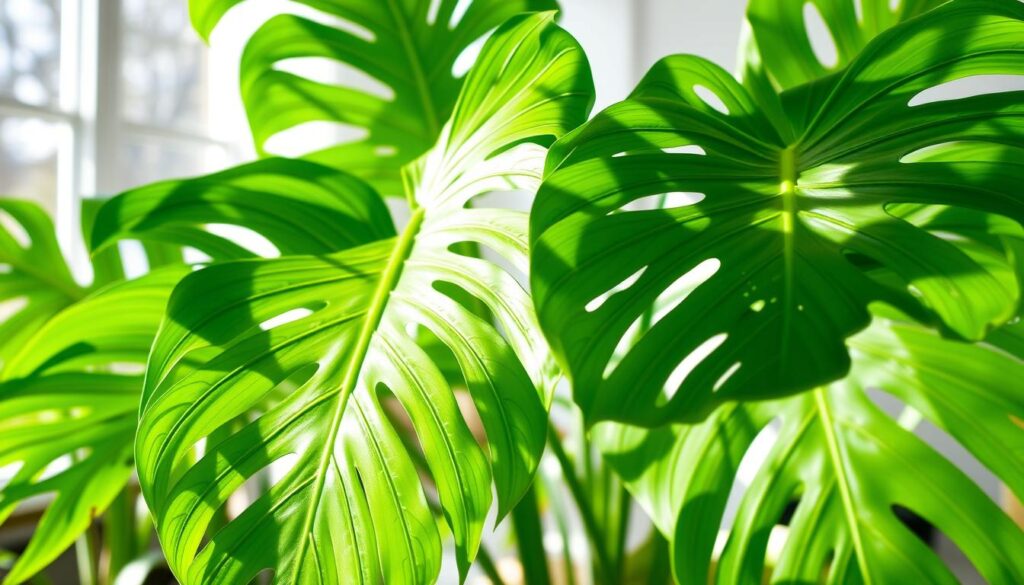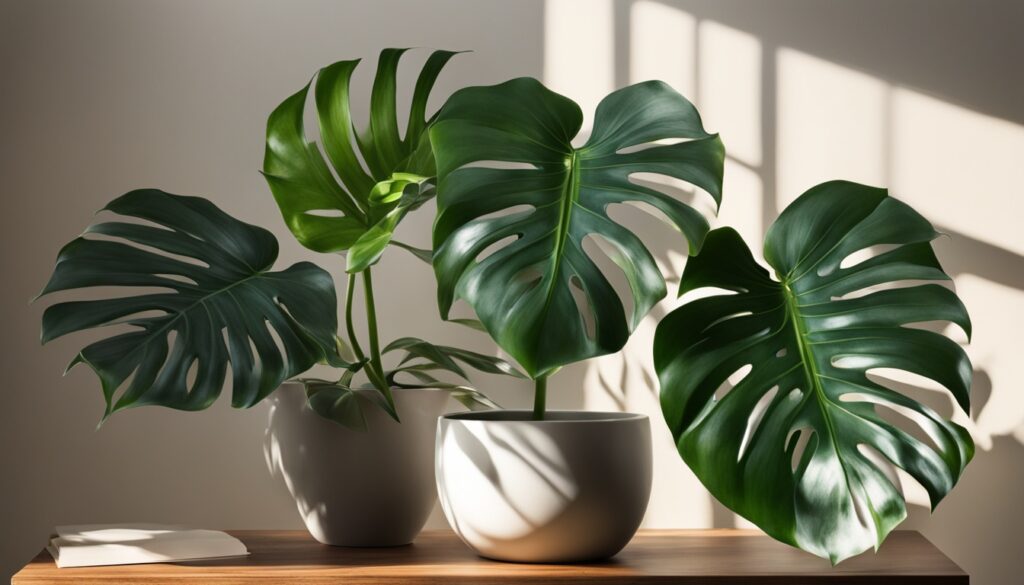More than 50 species exist in the Monstera genus. These lush, tropical-looking houseplants are a favorite among plant lovers. But, regular pruning is key to keep them healthy and looking good. Monstera deliciosa, or Swiss cheese plants, can grow too big for indoor spaces fast.
By pruning them right, you control their size and shape. This also encourages new growth and makes the leaves look better. It keeps your Monstera happy in your home or office.
Monsteras root easily from stem cuttings. This makes it easy to share your plant with others. Knowing how to prune these plants well keeps them looking great and easy to care for.
Key Takeaways
- Monstera plants should be pruned during their active growing season, typically in spring or summer.
- Proper pruning techniques stimulate new growth and maintain the plant’s size and shape in indoor spaces.
- Pruning can also facilitate propagation by taking stem cuttings with aerial roots.
- Avoid over-pruning, as excessive removal of plant material can harm the Monstera.
- Understanding the plant’s growth habits is crucial for determining the best pruning approach.
Understanding Your Monstera Plant’s Growth Habits
To care for your Monstera plant right, knowing its natural growth is key. Monstera plants come from the tropical forests of Central and South America. They grow on the ground and up trees, using aerial roots to get moisture and nutrients from the air.
Growth Characteristics of Indoor Monsteras
Indoor Monstera plants can grow up to 10 feet tall. They have big, fenestrated leaves that can be 18 inches or more wide. But, their growth indoors might be different from outdoors.
Healthy Monstera growth shows in lush, vibrant leaves with holes and splits. Bad growth might mean stretched or sparse leaves. This shows the plant needs better care.
Signs of Healthy Growth vs. Problematic Growth
- Healthy growth: Large, fenestrated leaves, vibrant green color, and a balanced, compact shape.
- Problematic growth: Stretched or sparse foliage, leaves without fenestrations, or an uneven, leggy appearance.
Knowing the natural growth patterns of Monstera plants helps you care for them better. This ensures your indoor Monstera looks great and grows well.
“Proper care and pruning are essential for Monstera plants to maintain their signature large, fenestrated leaves and vibrant growth.”
| Monstera Growth Characteristics | Native Habitats | Indoor Settings |
|---|---|---|
| Plant Height | Up to 60 feet | Up to 10 feet |
| Leaf Size | Up to 3 feet across | Up to 18 inches across |
| Fenestrations | Fully developed | May be less pronounced |
| Growth Habit | Climbing, hemi-epiphytic | Trailing or climbing, depending on support |
Understanding Monstera plants’ growth habits helps you care for them well. This keeps them thriving in your home.
Benefits of Regular Monstera Plant Pruning
Keeping your Monstera plant healthy and looking good is key. Regular pruning does more than just make your plant look nice. It helps your indoor plant stay healthy for a long time.
One big monstera pruning benefit is controlling its size and shape. Monstera plants can grow really big, up to 10 feet indoors or 30 feet outdoors. Pruning keeps them the right size for your space.
Pruning also helps your Monstera grow new leaves and get nutrients better. By cutting off old or damaged parts, you encourage new growth. This makes your Monstera look better and stay healthy.
Pruning also stops pests and diseases. By removing dead or dying parts, you stop pests and diseases from spreading. This keeps your Monstera strong and healthy.
The best time to prune Monstera plants is from spring to early fall. This is when they can heal quickly from cuts. Use rust-resistant, stainless steel blades for your pruning shears. They last longer and make pruning easier.
Regular Monstera plant pruning has many benefits. It improves looks, growth, health, and longevity. By making pruning a part of your Monstera care, your indoor plant will stay beautiful and healthy for years.
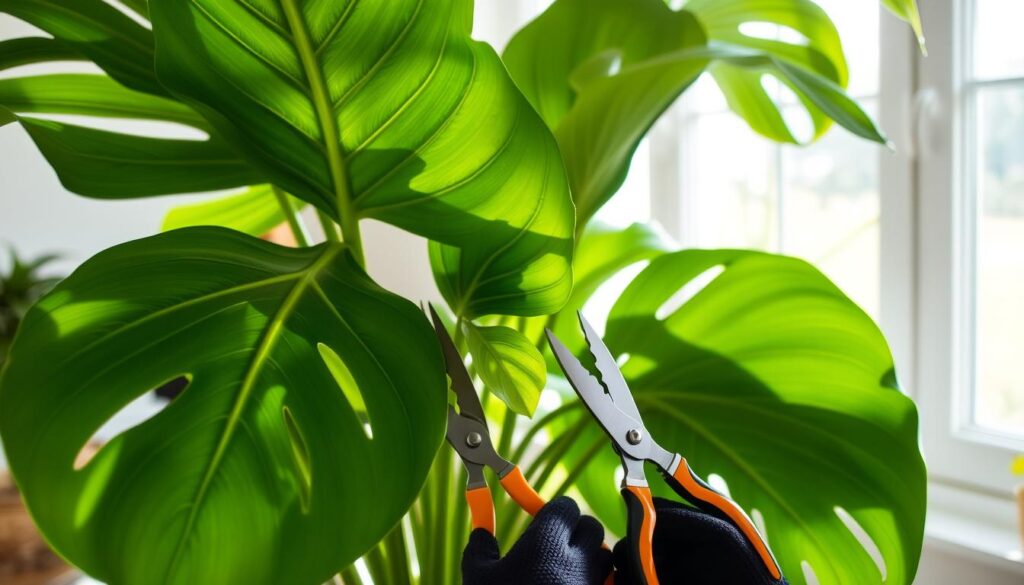
Essential Tools and Materials for Pruning
Proper pruning is key for your Monstera plant‘s health and looks. You’ll need the right tools and materials for a successful prune. Let’s look at the best equipment for Monstera pruning, safety gear, and how to keep things clean.
Recommended Pruning Shears and Equipment
A sharp pair of pruning shears is the base of good Monstera pruning. Choose shears with rust-resistant stainless steel blades for clean cuts. Serrated blades are good for some jobs too. Also, having bypass pruners for fine trimming is helpful.
Safety Gear and Protective Materials
Monstera plants have sap that can irritate your skin. Wear sturdy gardening gloves to protect your hands. Look for gloves that are durable, waterproof, and have a good grip. Safety glasses can also help keep your eyes safe from debris or sap.
Cleaning and Sanitizing Tools
Cleaning and sanitizing your pruning tools is vital to keep your Monstera healthy. Use isopropyl alcohol or a disinfectant solution to clean the blades. Also, have leaf shine wipes ready to make your plant look great after pruning.
With the right monstera pruning tools and plant pruning equipment, you can prune your Monstera with ease. This ensures your plant stays healthy and beautiful for years to come.
Best Times for Monstera Maintenance
Pruning your Monstera plant at the right time is key for its health and look. The best time to prune is in early spring, during the active growing season. This lets the plant heal fast and grow new, vibrant leaves.
Small Monstera plants need pruning once a year. But bigger, denser plants might need more trimming to keep their shape. Fast-growing types like Adansonii and Siltepecana might need pruning more often to stay looking good.
Pruning helps get rid of brown stems, yellow leaves, and messy growth. It encourages the plant to grow new, healthy leaves. Even though Monstera plants can live without pruning for years, regular trimming keeps them in great shape.
Don’t prune Monstera plants in winter. They rest during this time to save energy. But in places with steady temperatures and light, you can prune all year.
When you prune, use clean, sharp tools and wear gloves. Clean your hands and tools afterward to avoid diseases and skin problems. Cutting just above a node can help the plant grow new leaves and even start new plants.
Pruning Monstera plants at theright time and correctly can greatly improve their health and beauty.
Identifying Areas That Need Pruning
Keeping your Monstera plant healthy and looking good means you need to prune it often. It’s important to spot the parts that need fixing and fix them fast. This way, your Monstera will stay happy and healthy.
Dead or Yellowing Leaves
If your Monstera has dead or yellow leaves, it’s time to prune. These leaves can make your plant look bad and use up its energy. Make sure to cut off any dead or yellow leaves. This will help your plant grow new, green leaves.
Overgrown Sections
As Monstera plants get older, they can grow too long and lose their shape. Look for these long, stretched-out parts and trim them. This will help your plant look better and keep it healthy by letting air move around it.
Diseased Parts
Check your Monstera for any signs of sickness or pests. Look for things like color changes, wilting, or weird growths. If you find any, cut off the sick parts right away. Getting rid of sick parts is key to keeping your Monstera healthy.
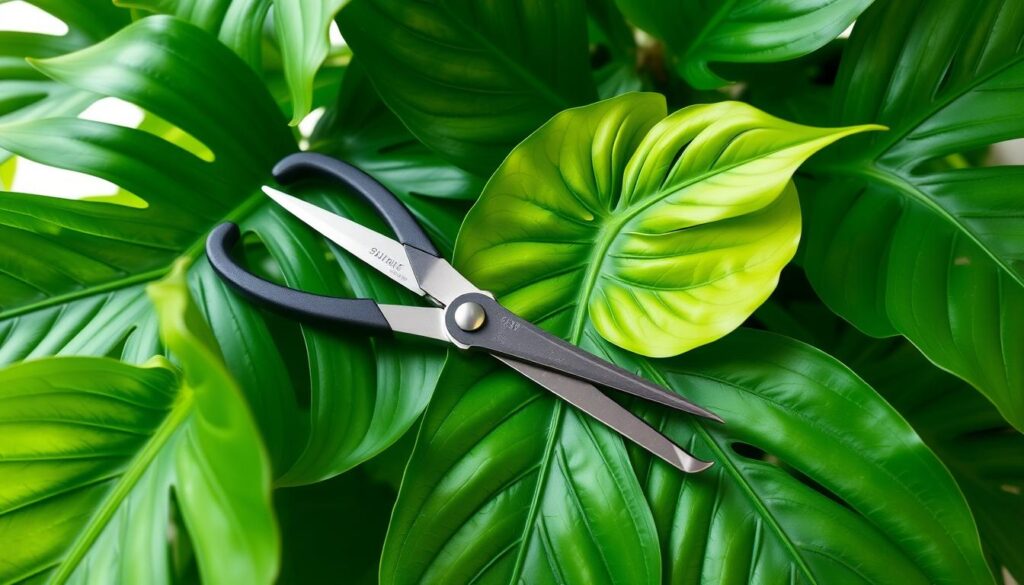
Pruning your Monstera right is all about knowing what needs fixing and fixing it carefully. By keeping an eye on your plant and fixing problems, you can keep your Monstera looking great for a long time.
Basic Monstera Plant Pruning Techniques
Keeping your Monstera plant healthy and looking good needs careful pruning. When you’re pruning monstera, cut at a 45-degree angle just above a node. Use sharp, clean shears to help the plant heal fast and grow new leaves. Don’t cut too close to the node or leave long pieces, as this can harm the plant.
Plan your how to prune monstera cuts to keep the plant’s shape. It’s best to remove 25-30% of the leaves at once. This lets the Monstera recover without getting too stressed.
Timing is Everything
The best time to prune Monstera is in early spring, when it’s growing fast. This way, the plant can quickly heal and grow new leaves. Young Monstera plants might only need pruning once a year. But bigger, denser plants might need more trimming to stay in shape.
Proper Pruning Techniques
- Find the nodes on the Monstera stem, where new growth starts.
- Make clean cuts just above or below the nodes, depending on what you want.
- Use sharp, clean shears or scissors to make a clean cut and avoid disease.
- Don’t over-prune, as cutting off too much can stress the plant.
- Think about the plant’s shape and balance when you decide where to cut.
Learning these monstera pruning techniques will help keep your Monstera plant healthy and beautiful. Remember, pruning is a key part of caring for your Monstera.
For more tips on growing Monstera, check out this guide on how to propagate pothos. The methods work for Monstera too, helping you grow new plants from your current ones.
Managing Aerial Roots for Optimal Growth
Aerial roots are a fascinating part of Monstera plants. They offer support and extra water. These roots grow from the stem above the soil, especially in epiphytic and vining plants. As Monstera plants mature, their aerial roots can grow long, adding to their unique look.
Managing aerial roots is key for your Monstera’s health and beauty. You can trim long aerial roots near the stem without hurting the plant. Or, you can cut entire stems with nodes for propagation.
When to Remove Aerial Roots
Aerial roots grow randomly but won’t harm your plant. They can even enhance your indoor decor. But, if they get too long or block movement, it’s time to trim them.
Proper Cutting Techniques
- Use clean, sharp pruning shears to cut aerial roots close to the stem, allowing the plant to heal the wounds effectively.
- Avoid cutting the aerial roots too short, as this can stress the plant. Aim to leave a small stub attached to the main stem.
- Consider guiding aerial roots into the soil, as this can provide the plant with extra water and nutrients, potentially requiring sooner repotting.
- Support aerial roots with structures like mosspoles, bark, or sticks to mimic their natural environment and aid in structural support as they grow.
By managing aerial roots through strategic pruning and support, you can maintain the health and aesthetic appeal of your Monstera plant while encouraging optimal growth and development.
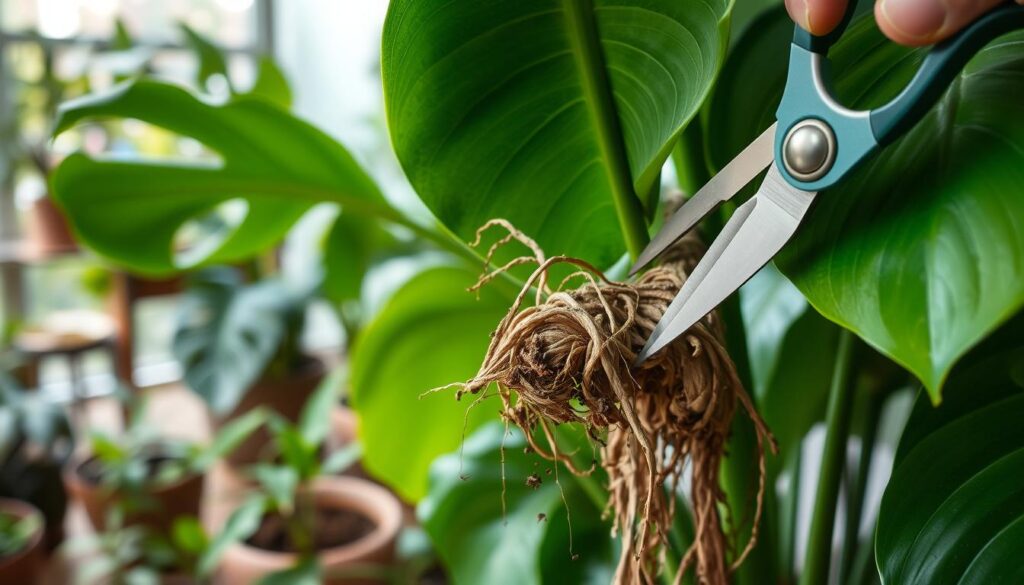
“Aerial roots provide Monsteras with the ability to affix to surfaces for climbing and help absorb water from surfaces and the air around them.”
Shaping Your Monstera for Aesthetic Appeal
Unlocking your Monstera plant’s full potential is more than keeping it healthy. It’s about creating a stunning piece of art. By shaping monstera plants through careful pruning, you can make your indoor space look like a tropical paradise.
Removing older leaves from the bottom of the plant is a key technique. This step boosts airflow and makes the plant look better. It also helps the top leaves grow fuller and greener. Trimming long leaves makes the plant look more compact and balanced.
For Monstera plants that look off-balance, pruning can fix this. By carefully cutting certain leaves or branches, you can shape the plant. Always cut just above a node to encourage new growth and keep the plant strong.
The art of shaping monstera plants blends gardening skills with creativity. By learning Monstera pruning, you can turn your plant into a stunning centerpiece. It will impress everyone who sees it. Discover the secrets to beautiful Monstera and take your indoor garden to new beauty levels.
Post-Pruning Care and Maintenance
After pruning your monstera aftercare, it’s key to clean and disinfect your tools. This stops diseases or pests from spreading. Use leaf shine wipes to get rid of sap and dust, making the leaves shine.
Clear out any debris or fallen leaves from the pot and around the plant. This keeps your plant looking neat and cared for. You might also want to apply a protective coating to the cuts to prevent pests and diseases.
Make sure your monstera gets enough water and sunlight after pruning. This helps it heal fast and grow new leaves. Good care will make your plant strong and healthy again.
| Pruning Aftercare Essentials | Recommended Practices |
|---|---|
| Cleaning and Disinfecting Tools | Use rubbing alcohol to sterilize pruning shears before and after use |
| Leaf Maintenance | Apply leaf shine wipes to remove sap and dust, restoring luster |
| Pot and Area Cleanup | Clear away any fallen leaves or debris around the plant’s base |
| Protective Coatings | Consider using a leaf armor to safeguard pruning cuts |
| Watering and Lighting | Ensure proper moisture and sunlight exposure to aid recovery |
By following these monstera aftercare tips, your plant will quickly recover from pruning. It will keep thriving in your home or office.
“Regular pruning is essential for maintaining the health and appearance of your monstera plant, but it’s just as important to provide proper post-pruning care to ensure a smooth recovery.”
Common Pruning Mistakes to Avoid
Keeping your Monstera plant healthy needs careful pruning. But, there are common mistakes that can harm your plant. These include cutting too much, using the wrong tools, and pruning at the wrong time. Knowing these mistakes helps you keep your Monstera looking great.
Excessive Cutting
Don’t over-prune your Monstera. Try to remove no more than 30% of the leaves at once. Cutting too much can shock the plant, slowing its growth. Instead, prune a little at a time to help your Monstera grow well.
Improper Tool Usage
Using the right tools is key when pruning. Make sure your shears or scissors are clean and sharp. Cut at a 45-degree angle above the leaf node to help water run off and prevent disease. Don’t leave stubs or damaged areas, as they can harm new growth and attract pests.
Wrong Timing Concerns
Pruning at the right time is important. Prune in spring and early summer when your Monstera is growing. Don’t prune in fall and winter, as it can slow growth. Prune at the right time to help your Monstera thrive.
Avoiding these common mistakes keeps your Monstera healthy and beautiful. Regular, careful pruning is essential for its iconic shape and lush leaves. For more Monstera care tips, check out our guide here.
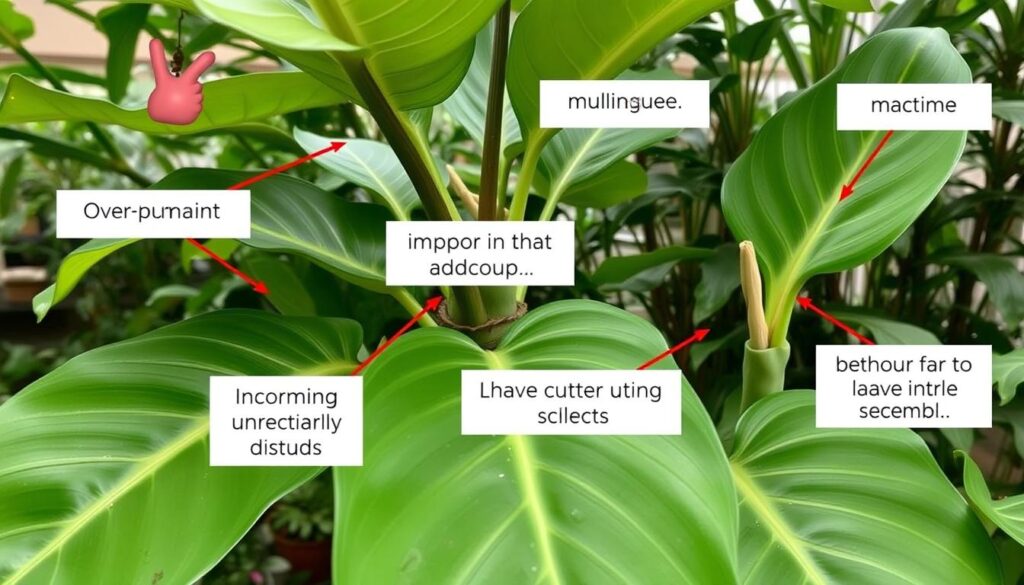
Propagation Through Pruning
Monstera plants are known for their lush, tropical leaves. But did you know pruning can help you grow more? By cutting and rooting stems, you can multiply your Monstera collection. Monstera propagation methods through pruning are rewarding and budget-friendly for your indoor garden.
When you prune your Monstera for propagation, look for stems with a node and two leaves. Use sharp, clean shears to cut just below the node. Nodes are key for new roots to grow, as they have the right hormones and cells.
- Prepare a container with a well-draining mix or water for the cutting.
- Dip the cut end in rooting hormone powder or liquid to help roots grow faster.
- Put the cutting in the container, making sure the node is in the medium.
- Water the soil lightly or change the water to keep it moist around the cutting.
- Watch the cutting for weeks until new roots appear. Then, move it to a bigger container with fresh mix.
Stems with aerial roots often do better when propagated. These roots are ready to grow quickly. By using these pruning for propagation steps, you can grow new Monstera plants. This way, you can share these beautiful plants with others.
| Propagation Method | Advantages | Disadvantages |
|---|---|---|
| Stem Cuttings |
|
|
| Air Layering |
|
|
“Pruning Monstera plants for propagation is a wonderful way to share these incredible plants with others and expand your indoor jungle.”
Dealing with Pest and Disease Issues During Pruning
Before you start pruning your Monstera, check it for pests or diseases. Monstera pest control is key to keeping your plant healthy. If you find any affected leaves or stems, cut them off right away.
If your Monstera has a big problem, treat it first. This helps the plant heal better. Always clean your tools after each cut to prevent spreading disease.
It’s important to prune diseased Monstera plants carefully and throw away the infected parts. This keeps your Monstera healthy and strong. By tackling pests and diseases early, your Monstera will do well after pruning.
